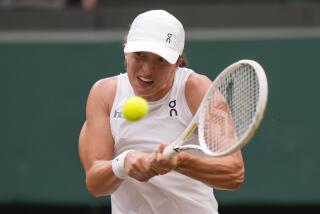When It Rains, She Pours It On for Media : Wimbledon: Shriver is slipping in stature, but after a first-round victory over an old neighborhood chum, she shows that she can still talk a good game.
WIMBLEDON, England — If Pam Shriver could play tennis as well as she can talk about it, nobody would ever beat her.
The likable serve-and-volley veteran from the Baltimore suburb of Lutherville, Md., who will turn 29 on July 4 and whose best tennis is probably behind her, is known in the news biz as “a great interview.”
Wednesday, when the persistent rain washed out all but a few matches at Wimbledon, Shriver’s ability to talk became more valuable to the story-starved media than her ability to play.
Shriver burst on the world tennis scene as a tall, big hitter in 1978, when she made it, at 16, to the U.S. Open final. She has been a semifinalist three times in the Australian Open, three times at Wimbledon and two additional times after ’78 in the U.S. Open. She has won 21 Grand Slam doubles titles, including 20 with Martina Navratilova, and also won a gold medal in the 1988 Olympic Games at Seoul, taking the women’s doubles with Zina Garrison.
But she hurt her shoulder, had surgery, played little in 1990 and has battled back to a No. 38 ranking. She is unseeded here for only the third time in 13 years.
So when she took the court for her first-round match Wednesday, it was not Centre Court, nor any of the show courts. She played No. 126-ranked Andrea Leand, and her gallery consisted of those loyal few, maybe 200, who got there early enough to find seating in one of the two rows alongside Court 4, plus another couple of hundred who paused while en route to other courts. There are lots of rings in this daily circus, but the Shriver match was nowhere near the center ring.
Nor did it deserve to be until the end, when Shriver, having won the first set, 6-0, and gone up a break to be serving for the match at 5-4, suddenly found herself facing a rejuvenated Leand. It took Shriver seven match points and until 7-5 to close out the match, and she did so as the rains began again.
“She didn’t even look like she could break for most of the match,” Shriver said. “It looked like a pretty routine, six-love and one break in the second first-rounder. But all of a sudden, the last 10 minutes got kind of dramatic.”
Shriver said she had made the mistake of noticing dark clouds closing in and, because of that, rushed her game. “You can’t play with weather pressure, it gets you all messed up,” she said.
Shriver called the match “a battle of Old Court Road” because she and Leand, two years her junior, both live in the same community.
“We grew up within a half-mile of each other, I know her family and have played on her court and she’s played on mine. Sure is strange, you come to Wimbledon, they have a 128 draw, and you end up playing somebody who lives right down the street from you. It’s all right, but it is kind of awkward.
“I’ve played her before. The first time was in Atlanta, and I was kind of uptight about it, because we do know each other pretty well. But it ended up being an easy one-and-love win, and I went on to win that tournament. The next year, they canceled that tournament. That’s kind of par for my career.”
Shriver said Leand “was pretty bad” in the first set, adding: “She would say that herself, I’m sure.
“I started fast against her, and that seemed to kind of put her off. In the first game, I hit a return backhand passing shot up the line. I hit about five of those a year.”
So much for the match. Shriver also commented on, among other things, the mysterious no-show of Monica Seles and the continuing slump of Steffi Graf.
“I just don’t understand the Monica thing, how the top player in the world could pull out of this three days before it starts,” Shriver said. “You just have to be more open when you are in her position. She should have at least held some sort of radio hookup or press conference. It’s almost like she is enjoying the mystery.
“I wouldn’t be totally surprised if she had just burned herself out and that the thought of coming here and trying to be competitive was just too much for her.
“In lots of ways, I can understand that. I look at (Bjorn) Borg and I have no idea how he did the French and Wimbledon so well for so many years. But remember, by the end of the summer, he was totally fried for the U.S. Open, which he never won.”
And Graf?
“I’ve never known anybody as inflexible as Steffi,” Shriver said. “I think one of the things that happened to her was that people started to adapt to her game. We got used to her pace. We got people to hit (with her) pace at us in practice. After one or two years, there’s no longer the intimidation factor. We got better at handling Steffi.
“I have never seen a change or adaptation by Steffi during a match. I mean, what has she added to her game in the last few years? A drop shot, maybe, but not a lot more. I don’t know if that is coaching, or just the inflexibility of her personality.
“What she did in 1988 (winning all four Grand Slam tournaments plus the Olympic gold medal) took a certain kind of locked-brain personality, a certain stubborn approach, (being) focused . . . all those words.
“I’ve seen all her recent matches with (Gabriela) Sabatini, and I can’t believe that she hasn’t come up with something different to try. But she doesn’t. It’s all the same.”
Then there was the issue of Wimbledon locker rooms. The media is barred from the locker rooms, and that automatically makes everyone more interested in them. So, they find Pam Shriver to talk about what goes on there.
“All but maybe two years, I have been in Locker Room No. 1, the place for the 16 seeded players in singles and the top two doubles teams,” Shriver said. “This year, I’m not seeded and I’m in Locker Room No. 2.
“When I walked in there--it’s down in the basement and there aren’t any windows--I kind of went into a 10-minute sulk. I never felt like I was demoted before. But I’m fine about it now. I actually kind of like it.
“The seeded players’ locker room is upstairs, with windows and a lounge area. I’ll tell you the difference. If you have a drink up there and you want to put it on a table, you use a coaster. In Locker Room No. 2, all our tables have spilled drinks all over them.
“And there’s a pretty good rivalry. When Martina (Navratilova) was playing Elna Reinach yesterday, all the people in Locker Room No. 2 were rooting for Elna, kind of because she was one of us. Now, Martina is my doubles partner, so it was different for me, but that sort of thing goes on a lot. In Locker Room No. 3, where they have the qualifiers and players ranked in the 100s and the juniors, they have a party if somebody wins a first-rounder.
“If one of the seeded players walks into the other locker rooms, everybody hollers at them and tells them to get out.”
So what will she do when it’s time for Navratilova and her to walk out together to play doubles.
“I’ll make her come to Locker Room No. 2,” Shriver said.
More to Read
Go beyond the scoreboard
Get the latest on L.A.'s teams in the daily Sports Report newsletter.
You may occasionally receive promotional content from the Los Angeles Times.











